
The Lyman Estate, also known as The Vale, is a historic country house located at 185 Lyman Street, Waltham, Massachusetts, United States. It is now owned by the nonprofit Historic New England organization. The grounds are open to the public daily for free; an admission fee is required for the house.
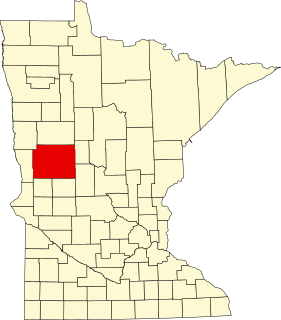
This is a list of the National Register of Historic Places listings in Otter Tail County, Minnesota. It is intended to be a complete list of the properties and districts on the National Register of Historic Places in Otter Tail County, Minnesota, United States. The locations of National Register properties and districts for which the latitude and longitude coordinates are included below, may be seen in an online map.
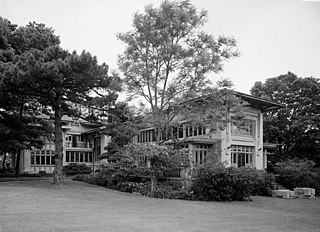
The Bernard Corrigan House is a historic residence at 1200 West 55th Street in the Country Club District, Kansas City, Missouri. The building is an important regional example of the Prairie Style, and it was one of the earliest residential structures in Kansas City to make extensive use of reinforced concrete. It was added to the National Register of Historic Places in 1978.

Phelps County Courthouse is a historic courthouse located in Rolla, Phelps County, Missouri. The original section was built between 1860 and 1868 and is a two-story, Greek Revival style brick building. The original building measures approximately 45 feet by 65 feet. It sits on a stone foundation and has a low-pitched gable roof. A series of additions were made in 1881, 1912, c. 1950, and 1979.

The Chatol also known as The Chance Guest House is a historic home located at Centralia, Missouri. It was built in 1940, and is a large, two-story residence, "U"-shaped in plan, with a basement. It is reflective of the Streamline Moderne and International Style architecture. The house measures approximately 136 feet by 92 feet. It was constructed in a swampy location and has steel footings on a concrete foundation, with a spring system employed in the walls. It features strips of louvered windows in the sun room and the wood and metal framed casement windows that traverse the walls and most of the squared and curved corners of the house.

The Samuel H. and Isabel Smith Elkins House is a historic home in Columbia, Missouri. The home is located just north of Downtown Columbia, Missouri on 9th street and today contains an artisan glassworks. The large two-story brick residence was built about 1882 in the Italianate style.
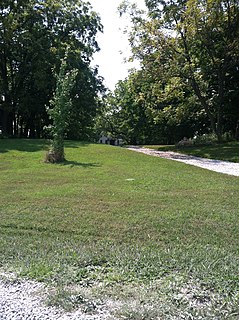
The Moses U. Payne House, also known as Lynn Bluffs and Roby River Bed and Breakfast, is a historic home near the Missouri River in Rocheport, Missouri. It was constructed in 1856-1857, and is a large frame central hall plan I-house. It is five bays wide and features an ornamental ironwork front porch.
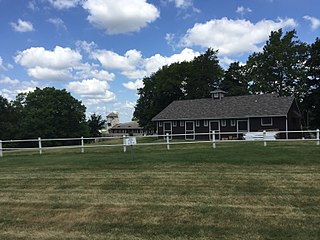
Cragwold, also known as Edwin A. Lemp Estate, in St. Louis County, Missouri was built in 1911.
Phelps House may refer to:

The Jasper County Courthouse is a historic courthouse located at Carthage, Jasper County, Missouri. It was built in 1894-1895. This highly photographed Richardsonian Romanesque edifice designed by architect Max A. Orlopp Jr. was constructed with local Carthage marble and has medieval castle features that include turrets, towers, and arches. It is the second most photographed building in Missouri. It remains in use by Jasper County officials.

The Joplin Carnegie Library is a historic Carnegie library located at Joplin, Jasper County, Missouri. It was built in 1902, and is a two-story, Classical Revival style steel frame building sheathed in brick and white Carthage marble. It measures 79 feet by 86 feet and features a pedimented Ionic order porch which is distyle in antis. A four-bay two story addition was added in 1916. Andrew Carnegie provided $40,000 for its construction.
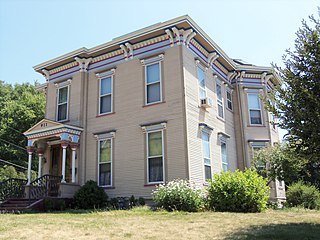
The James E. Lindsay House is a historic building located on the east side of Davenport, Iowa, United States. It has been listed on the National Register of Historic Places since 1984.

This is a list of the National Register of Historic Places listings in Phelps County, Missouri.

St. Peter the Apostle Catholic Church and Rectory is a historic Roman Catholic church and rectory located at 812 Pearl Street in Joplin, Jasper County, Missouri. The church was built in 1906, and is a Late Gothic Revival style building constructed of Carthage limestone. It measures 63 feet, 6 inches, by 122 feet, 8 inches and features circular windows; tracery; Gothic arched windows and doors; and the triple portal entry. The rectory was built in 1917, and is a two-story Prairie School style dwelling with a finished basement. It is constructed of Carthage limestone and has a low pitched, hipped roof with wide overhang. Also on the property is a contributing concrete block garage.
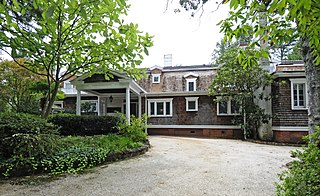
The Phelps House, is located in Aiken, South Carolina. The house was built in the early 1900s on the foundations of an antebellum house that had been destroyed during the Civil War, is historically significant for several reasons, one of which is its very distinctive Shingle Style. This style, used often in the late 1800s and early 1900s in the resort homes of the rich, was rarely used in South Carolina. The large house has over 20 rooms, and the grounds, include the stables, garage, greenhouses and kennels. As of 2012, the home is available for commercial purposes and due to this use, can be readily viewed and enjoyed. It was listed in the National Register of Historic Places on June 10, 1974.

The House in the Horseshoe, also known as the Alston House, is a historic house in Carthage, North Carolina in Moore County, and a historic site managed by the North Carolina Department of Natural and Cultural Resources' Historic Sites division. The home, built in 1772 by Philip Alston, was the site of a battle between loyalists under the command of David Fanning and patriot militiamen under Alston's command on either July 29 or August 5, 1781. The battle ended with Alston's surrender to Fanning, in which Alston's wife negotiated the terms with the loyalists.

Carthage Courthouse Square Historic District is a national historic district located at Carthage, Jasper County, Missouri. The district encompasses 42 contributing buildings in the central business district of Carthage. It developed in the late-19th and early-20th centuries and includes representative examples of Italianate and Romanesque Revival style architecture. Located in the district is the separately listed Jasper County Courthouse. Other notable buildings include the Bank of Carthage, Ben Franklin Store (1920s), Farmers and Drovers Bank / Miller Clothing Company, Belk-Simpson Building (pre-1884), Carthage Water & Electric Co. (pre-1884), Snyder Building (1901), Drake Hotel (1920), Fire Department (1883), Leggett and Platt (1920), McNerney Block (1905), and Carthage National Bank.

Carthage South Historic District is a national historic district located at Carthage, Jasper County, Missouri. The district encompasses 491 contributing buildings in a predominantly residential section Carthage. It largely developed between about 1875 and 1925 and includes representative examples of Late Victorian and Bungalow / American Craftsman style architecture. Notable buildings include St. Ann's Catholic Church (1908), Former Westminister Presbyterian Church (pre-1888), First United Methodist Church (1925), Carthage Senior High School (1904), First Christian Church (1909), Former Cumberland Presbyterian Church (1892), and Carthage Public Library (1904).

Cassill Place Historic District is a national historic district located at Carthage, Jasper County, Missouri. The district encompasses eight contributing buildings in an exclusively residential section Carthage. It developed between about 1890 and 1925 and includes representative examples of Late Victorian and Bungalow / American Craftsman style architecture. The buildings include the Macoubrie House (1903), Former Herrin Home, Fenimore House, McFadden House, Meister House, A. H. McFadden House (1914), Former Eugene O'Keefe House, and Dennison House.

Four Mounds Estate Historic District is a nationally recognized historic district located in Dubuque, Iowa, United States. It was listed on the National Register of Historic Places in 2002. At the time of its nomination the district consisted of 19 resources, including 11 contributing buildings, two contributing sites, four non-contributing structures, and two non-contributing buildings. The estate is named for the four conical burial mounds that are located on the property. They are one of the historic sites, and they are individually listed on the National Register of Historic Places.
























